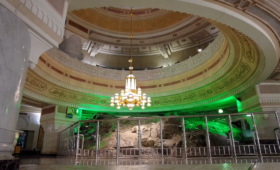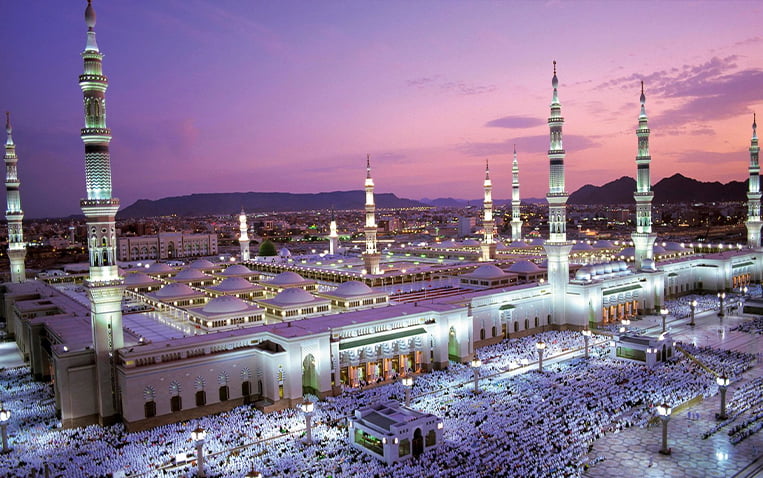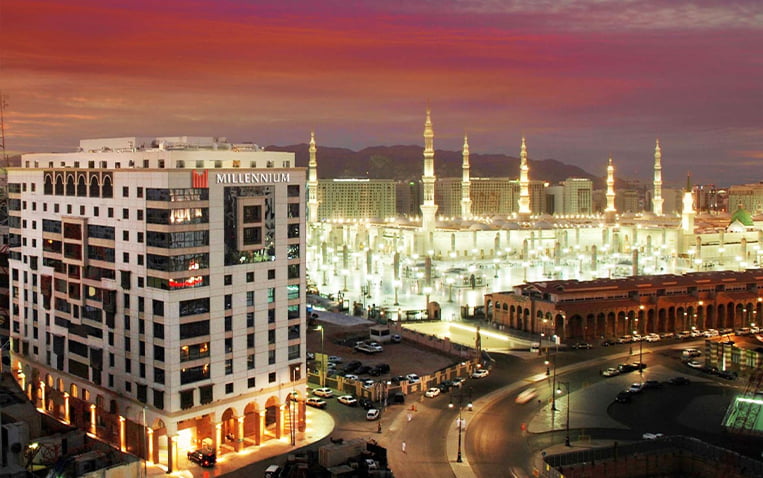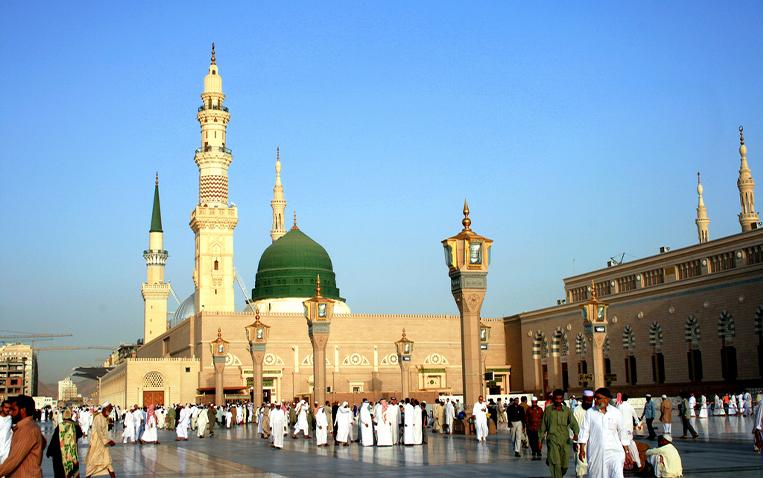The Islamic world is rich with history, culture, and spirituality, reflected in the numerous religious sites that attract millions of visitors each year. From iconic mosques to holy cities, these destinations hold significant religious and cultural importance for Muslims worldwide.
Islam, the second-largest religion in the world after Christianity, began in Arabia and has about two billion believers worldwide. While Makkah is the holiest destination for Muslims, there are other important Muslim memorials, such as gilded mosques, shrines with mosaic floors, and holy cities, which are not only beautiful constructions but also provide unique insights into Islam’s history and culture.
Most Popular Muslim Holy Sites in the World
- The Holy Kaaba, Makkah
- Al-Masjid an-Nabawi, Madina
- Al-Aqsa Mosque, Palestine
- Blue Mosque (Sultan Ahmed Mosque), Turkey
- Sheikh Zayed Grand Mosque, Abu Dhabi
- Great Mosque of Algiers, Algeria
- Great Mosque of Kairouan, Tunisia
The Holy Kaaba, Makkah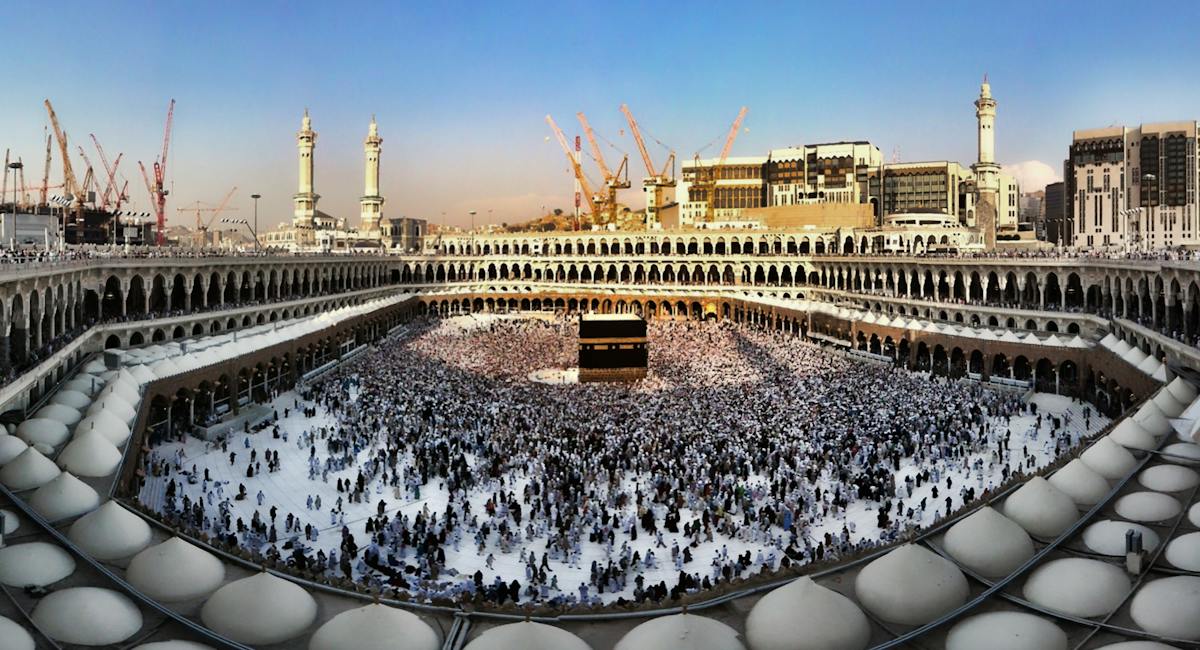
The Kaaba, the holiest place in Islam, is situated in the center of Mecca’s Masjid al-Haram. By performing the Hajj pilgrimage to this holy place, Muslims from all over the world fulfill one of the Five Pillars of Islam. This location has unmatched spiritual significance due to the huge number of pilgrims who assemble on the yearly Hajj trip.
Makkah is a city in western Saudi Arabia, situated inland from the coast of the Red Sea in the Sirat Mountains. Muslims turn their heads five times a day in prayer toward Makkah, the birthplace of Islam’s founder, Muhammad (PBUH).
Religious Pilgrimages
One of the Five Pillars of Islam, the yearly Hajj pilgrimage, ends in Makkah. The Hajj is a mandatory pilgrimage that every financially capable as well as mentally fit Muslim must make at least once in their lifetime.
Millions of pilgrims from all walks of life gather for the Hajj in the Islamic month of Dhu al-Hijjah to participate in rites honoring the deeds of Prophet Ibrahim (Abraham) and his family.
Masjid al-Haram
One of the biggest mosques in the world is the Masjid al-Haram, which is located around the Kaaba. Millions of pilgrims stay there during the Hajj and Umrah pilgrimages. In order to accommodate the increasing number of pilgrims, the mosque has undergone significant expansions across the years, and it now includes important architectural features and landmarks.
Zamzam Well
Located within the Masjid al-Haram, the Zamzam Well is considered sacred by Muslims. According to Islamic tradition, it is believed to have originated miraculously for Hagar and her son Ishmael when they were in need of water.
Historical Significance of Makkah
Makkah has a rich and long tradition that dates back thousands of years. It was a major center for trade and religion even before Islam arrived. The city held great significance for Prophet Muhammad, as it was the place of his birth, early growing up, and prophetic career beginnings.
Al-Masjid an-Nabawi, Madina
It is the second-holiest place in Islam and includes the Prophet Muhammad’s tomb. Pilgrims come to the mosque to offer prayers and find comfort in the peaceful surroundings. Every year, millions of Muslims travel to the Prophet’s Mosque (Masjid an-Nabawi) to pray.
History and Significance
The Prophet’s Mosque, Al-Masjid an-Nabawi, is highly significant both historically and religiously in Islam. Constructed by the Prophet Muhammad (PBUH), it is the second-holiest mosque in Makkah, behind the Kaaba.
Architectural Features
The mosque has an impressive and distinctive architectural style. Its recognized green dome and minarets add to its unique look. Over the ages, the mosque has had multiple expansions to suit the increasing number of worshipers.
Rawdah
“The space between my house and my pulpit is one of the gardens of Paradise,” declared the Prophet Muhammad (PBUH). (Bukhari) Imam Ibn Hajr Al-Asqalani (may Allah SWT have compassion on him) stated that the meaning of Rawdah is the “Garden of Paradise,” also known as “Riyad Al-Jannah,” in light of the above hadith.
Prophet’s Burial Site
Al-Masjid an-Nabawi is also home to the Prophet Muhammad’s (PBUH) burial site. The chamber is marked by a simple green dome and holds immense spiritual significance for Muslims worldwide.
Current Status and Importance
Today, the Prophet’s Mosque has become a symbol of solidarity and devotion for Muslims worldwide. Pilgrims from all over the world visit this holy mosque to experience a spiritual environment and connect with the history of the Prophet (PBUH).
Al-Aqsa Mosque, Palestine
It is the holiest site for Shiya and Sunni Islam in the Old City of Jerusalem and is revered by Jews as the Temple Mount, site of the Holy Temple. It includes the Qibla Mosque and the Dome of the Rock. It is the third holiest site in Islam.
It was completed in 705 AD and is the second oldest mosque in the world and one of the holiest sites in Islam. This is because during the prophet Muhammad’s Night Journey he was transported from the Great Mosque of Makkah to Al-Aqsa. The 35 acres compound the mosque is a part of is called Al Haram Ash Sharif which means “The Noble Sanctuary.”
Blue Mosque (Sultan Ahmed Mosque), Turkey
The Blue Mosque, or Sultan Ahmed Mosque, is a masterpiece of Ottoman architecture located in Istanbul, Turkey. It is a symbol of Turkey’s rich cultural heritage which was constructed between 1609 and 1616 during the reign of Sultan Ahmed , it stands adjacent to the Hagia Sophia and faces the historic Hippodrome. The mosque is not only a place of worship but also a popular tourist attraction, drawing visitors with its stunning interior and exterior design.
Architecture
The mosque is renowned for its six slender minarets, a distinctive feature that sparked controversy during its time, as the Grand Mosque in Mecca was the only other mosque with that many minarets. The mosque’s exterior showcases a harmonious blend of domes, semi-domes, and minarets, creating an impressive silhouette on the Istanbul skyline.
Interior
The interior is equally striking, adorned with more than 20,000 handmade blue ceramic tiles that give the mosque its popular name. Intricate floral patterns, arabesques and calligraphy on the tiles create a calm and majestic atmosphere. The main prayer hall is capped by a large dome, and the mosque also houses various smaller domes and semi-domes.
Courtyard
The mosque features a spacious courtyard with an ablution fountain, surrounded by a colonnaded portico. The courtyard provides a tranquil space for worshipers and visitors alike.
Mihrab and Minbar
The mihrab (prayer niche) and minbar (pulpit) inside the mosque are crafted with fine marble and intricate woodwork. The mihrab indicates the direction of Mecca, while the minbar is used by the Imam for delivering sermons.
Istanbul’s Skylines
The Blue Mosque, with its cascading domes and elegant minarets, contributes significantly to Istanbul’s iconic skyline. It’s especially breathtaking during sunset and when illuminated at night.
Cultural Significance
Beyond its architectural grandeur, the Blue Mosque is a symbol of religious and cultural heritage. The mosque also serves as a reminder of the Ottoman era’s architectural prowess.
Sheikh Zayed Grand Mosque, Abu Dhabi
One of the biggest mosques in the world, the Sheikh Zayed Grand Mosque is a vast architectural marvel that intentionally combines elements of several Islamic architectural styles. It has more than 1,000 columns, 82 domes, 24-carat gold chandeliers, and the biggest hand-knotted carpet in the world. One of the biggest jewels in the world is the focal point of the main prayer hall.
This mosque was constructed by the late Sheikh Zayed bin Sultan Al Nahyan to symbolize historical significance as well as the Islamic values of tolerance, peace, and diversity. His goal was for the Grand Mosque to serve as a living example of contemporary Islamic architecture that bridges the past and present and establishes an Islamic center of study and research that upholds true Islamic principles.
Architecture
- Among the biggest mosques in the world
- intricate Islamic pattern with components made of white marble
- features flowery designs, domes, and minarets.
Main Prayer Hall
- Includes one of the biggest chandeliers in the world.
- Boasts the biggest carpet ever hand-knotted.
- Room over more than 40,000 worshipers
Great Mosque of Algiers, Algeria
The Great Mosque of Algiers, also known as Djamaa-el-Djazair, stands as one of the largest mosques in the world. Its majestic structure dominates the Algiers skyline, showcasing a blend of traditional and modern architectural elements. When it comes to capacity and sheer size of construction, its 2019-completed mosque is among the biggest in the world.
Design and Architecture
The mosque was designed by KSP Jürgen Engel Architekten and built by the China State Construction Engineering Corporation. Its design combines traditional Islamic architecture with modern elements, creating harmony between past and present.
The feature of the mosque is its large prayer hall that can accommodate up to 120,000 worshipers. There are smaller domes and minarets on both sides of the central dome, increasing the magnificence of the structure. The exterior shows intricate geometric patterns and calligraphy that pay homage to Islamic traditions. The use of white marble and other materials adds to the beauty of the mosque.
Great Mosque of Kairouan, Tunisia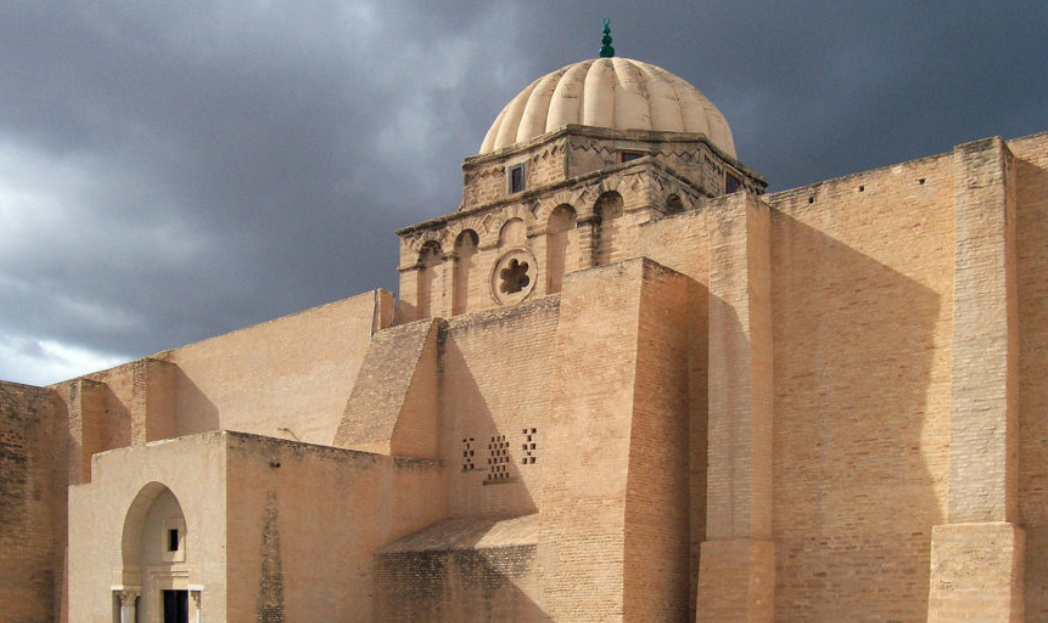
For over a thousand years, the Great Mosque has served as the focal point of worship for Arab Muslims. It’s a common belief that making seven pilgrimages to Kairouan could preserve your soul if you are unable to travel to Makkah.
Founded in A.D. 670, a mere 38 years following the demise of the Prophet Muhammad, it underwent reconstruction and expansion throughout the ensuing century. The current building is a part of a large complex in this holy city and was built during the ninth-century Arab-Muslim Aghlabid dynasty’s dominion over the Ifriqiyah region, which includes modern-day Tunisia and eastern Algeria.
The mosque served as a stronghold and a center of spirituality because of its supported walls and three-tiered tower, which is the oldest surviving minaret in the world and is decorated with battlements and arrow holes. A brilliant white courtyard, surrounded by temples and columns on three sides, sits in the heart of the mosque.
The doors leading to the prayer area, which is only open to Muslim men, have been decorated with magnificent marquetry, or marque. Inside are the 17 naves held up by carved columns, the mosaic-covered mihrab, a niche facing Mecca, and the minbar, or imam’s pulpit, which is regarded as the oldest remaining in the Islamic world.
Conclusion
Muslim religious sites reflect the rich Islamic culture, spirituality, and history. Visiting these places provides an opportunity for people to connect with their beliefs while also admiring the diverse architectural styles that have evolved over the years. Visiting Mecca or the Sheikh Zayed Grand Mosque provides a unique perspective on Islamic traditions and ideals.
Millions of Muslims rely upon the world’s largest mosque for spiritual and cultural shelter. Mecca is home to the Kaaba, Islam’s holiest shrine, and attracts millions of pilgrims during the Hajj each year. Medina and Masjid an-Nabawi are additional significant sites. Al-Aqsa Mosque in Jerusalem is Islam’s third holiest site, attracting both worshipers and tourists.
Sultan Ahmad Mosque in Istanbul, Great Mosque of Algeria. These places not only promote religious beliefs but also contribute to the rich architecture and history of the Islamic world. The continued importance of these sites reflects the global power of Islam and its deep connection to the faith of millions of people.
FAQ’s
What is the main place of Muslim pilgrimage?
The term pilgrimage in Islam is most usually associated with the hajj, the major pilgrimage to Makkah and its surrounding areas.
Why is Al Aqsa Mosque so important?
After Mecca and Medina, the mosque is regarded by Muslims as the third-holiest location in Islam. The Dome of the Rock and the Al-Aqsa Mosque are the two holy sites located in Al-Aqsa Plaza. In the eighth century AD, the mosque was constructed. Islamic scriptures claim that Prophet Muhammad spent a nightly journey into heaven from this location.
Why is Palestine important to Islam?
Al-Majali reviewed the historical journey of Palestine as the first qibla and the holy country of the Prophets Ibrahim and Isa (Peace Be Upon Them), drawing insights from the Quran and the Sunnah to establish the historical connection between Palestine and Islam.
Why is Jerusalem important to Muslims?
Jerusalem’s close connection to Abraham, David, Solomon, and Jesus contribute to its significance and holiness to Muslims. The Qur’an mentions them all, and they are all considered Islamic prophets.


